Ric rac cactus is a fast-growing and easy to care for plant, making it ideal for beginners. It’s durable and can survive a good amount of neglect too.
But before you add the zig-zag foliage to your houseplant collection, you should learn about what it needs to thrive.
This detailed ric rac cactus care guide will show you exactly what you need to know. You’ll discover what the water, light, soil, and humidity needs are, how to troubleshoot the most common problems, and more.

Ric Rac Cactus Quick Care Overview
| Scientific name: | Epiphyllum anguliger |
| Classification: | Orchid Cactus |
| Common names: | Ric Rac Cactus, Zig Zag Cactus, Moon Cactus, Queen of the Night |
| Hardiness: | Zones 10-11 |
| Temperature: | 60-75°F (15.5-24°C) |
| Flowers: | White blooms in late spring-summer |
| Light: | Partial shade outdoors, bright indirect light indoors |
| Water: | Keep soil evenly moist, do not overwater |
| Humidity: | High |
| Fertilizer: | General purpose plant food spring-summer |
| Soil: | Fast-draining, fertile, gritty |
| Common pests: | Mealybugs and scale |
Information About Ric Rac Cactus
The ric rac cactus (Epiphyllum anguliger) is a tropical epiphyte native to Mexican rainforests, where you’d find it anchored in the nooks of trees. It can absorb nutrients and moisture from the air and rainfall through its branches and roots.
The draping, leaf-like branches have rounded lobes that protrude from either side in an alternating pattern.
They can range between 2-9’ in length, with each averaging 6” wide with 1-2” lobes. The flat branches look like a dull saw edge, which is how this plant got the nicknames zig zag and ric rac cactus.
Different Types
There is only one type of Epiphyllum anguliger. But it has a similar appearance and growth habit to Selenicereus anthonyanus, aka the fishbone cactus. They are even often referred to by that same common name.
But the ric rac cactus is technically a different plant that has white flowers, and the lobes are closer together and more rounded. You can learn all about the fishbone cactus (Selenicereus anthonyanus) here.
Flowers
If your ric rac cactus is mature and gets 6 or more hours of bright light a day in early spring, it can produce nocturnal flowers that bloom for just one night. Its other nicknames, moon cactus and queen of the night, come from this nighttime flowering habit.
The orchid style blooms form at the end of long stems and feature off-white yellowish outer petals with a central white-colored blossom. They’re very fragrant and range between 4-5” across.
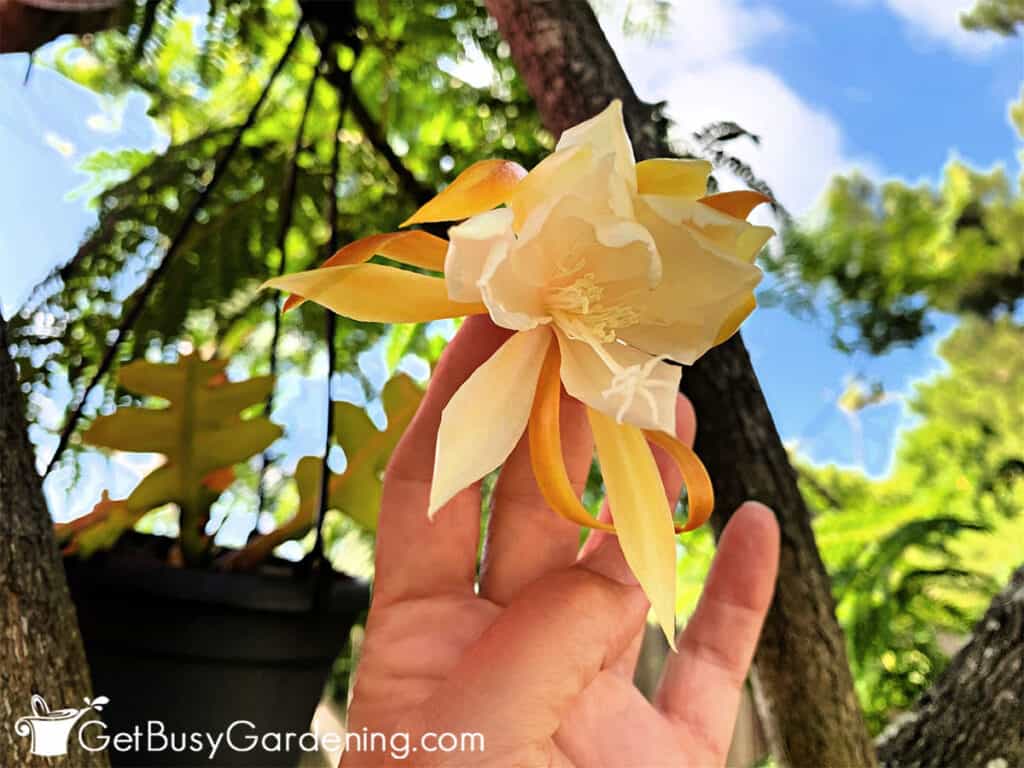
Toxicity
The ric rac cactus is not toxic to pets, so it’s a safe choice to grow near your cats and dogs. However, it develops small spikes or spines on the inside corners of the stems and on new growth, so it’s still a good idea to keep it out of reach.
If you’d like more information, please refer to the ASPCA website on toxic and non-toxic plants.
How To Grow Ric Rac Cactus
Before we talk about ric rac cactus care, we should discuss the best place to grow your plant. By choosing the right location, you’ll set it up for long-lasting health.
Hardiness
The ric rac cactus cannot tolerate extreme heat or cold. It requires temperatures between 50°F (10°C) and 80°F (26.6°C) to thrive. Anything outside this range can cause damage, and freezing temperatures will eventually kill the plant.
Due to its sensitivity to the cold, you can only grow it outdoors year-round if you live in zones 10-11. Otherwise you’ll have to keep it as a houseplant during the winter.
Where To Grow
Indoors, place your Epiphyllum anguliger near a bright window where it will get indirect light. But keep it away from AC vents or heaters, which can dry it out.
Outdoors, choose a shady location that receives dappled sun or only morning light, and pay close attention to the temperatures.
The draping nature of the stems makes it a popular choice for hanging baskets or planters, but you can also train it to climb. No matter the container you choose, it needs to have drainage holes in the bottom to prevent overwatering.
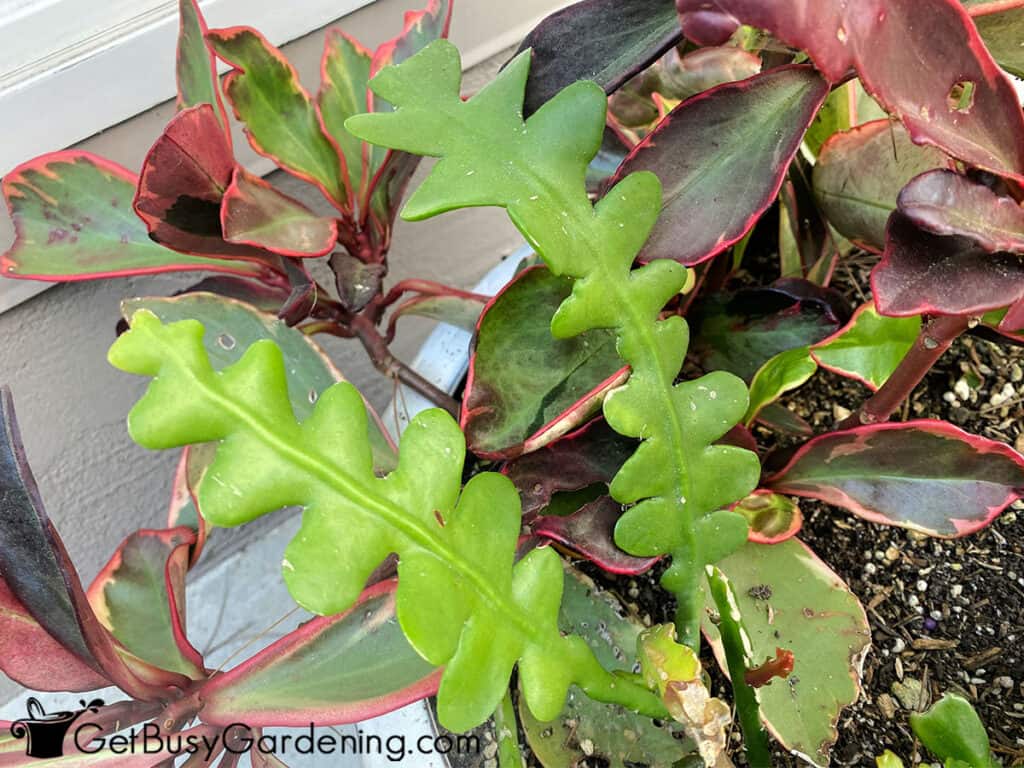
Ric Rac Cactus Plant Care & Growing Instructions
Now that you know where to grow it, we can chat about how to care for your ric rac cactus. Use the tips below to help create the perfect growing environment.
Light
Direct sunlight can burn the branches. So give your ric rac cactus bright, indirect light for 5-6 hours a day. An east or west-facing window that gets morning or evening sun is a good choice for indoor plants.
Outdoors, find a spot that gets partial or dappled shade and will protect your plant from the harsh, afternoon sun.
Getting the right amount of light in the spring is essential for blooming. If you have trouble providing 6 hours indoors, you can add a grow light to help supplement.
Water
The tropical nature of a ric rac cactus means it likes lots of moisture. However, overwatering can cause root or stem rot.
Water the soil whenever the top 1” dries out. But never oversaturate it to the point of being soggy, and ensure that any excess water drains from the pot.
In the winter, let it dry out more between drinks. When buds start to set in the spring, resume regular watering.
If you struggle to get it just right, use a moisture meter probe and keep it between 3-4 on the gauge.
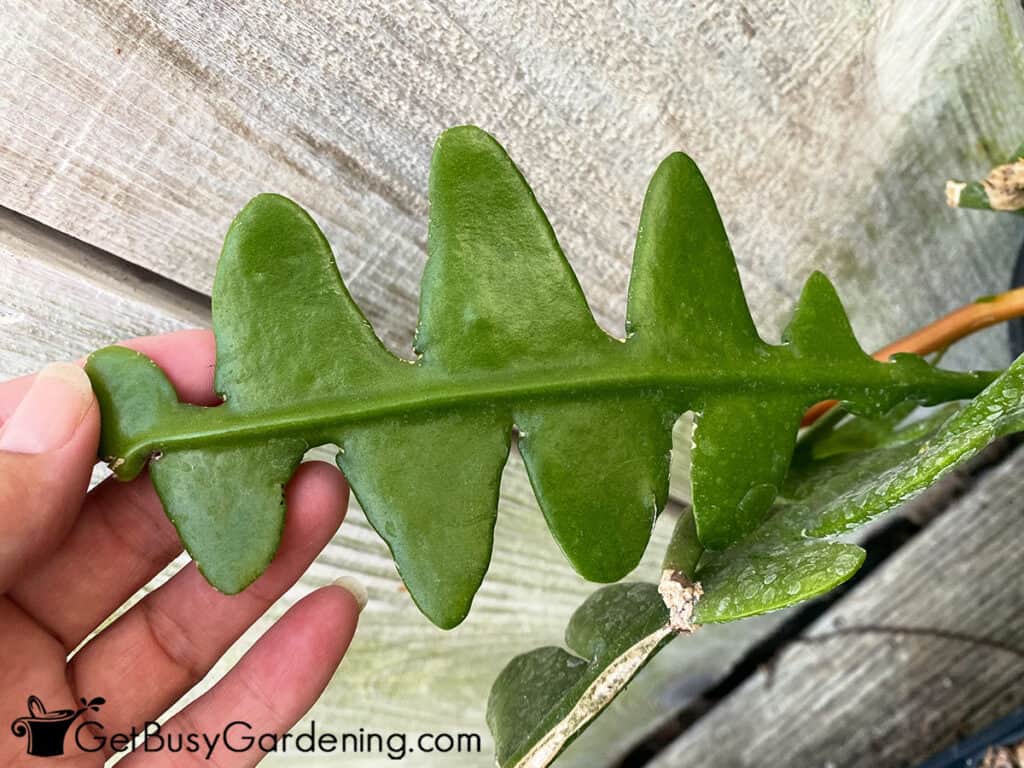
Humidity
Your Epiphyllum anguliger will thrive in high humidity, but it’s a very durable plant that can easily withstand drier indoor air too.
You can add a small humidifier, set the pot on a pebble tray filled with water, or lightly mist the branches occasionally to help increase humidity levels.
Temperature
Ric rac cactus plants prefers temperatures between 60-75°F (15.5-24°C), which makes them ideal to care for indoors.
Anything below 50°F (10°C) will stop growth, and below 40°F (4.4°C) will cause damage and ultimately result in death.
Temperatures above 80°F (26.6°C) can rapidly dehydrate your plant and can cause it to wilt.
Fertilizer
Regular feedings help support the rapid growth of a ric rac cactus, and stimulate flowering. Apply them in the spring and summer, then stop completely in the fall and winter.
Use a general purpose liquid, compost tea, or a cactus specific one monthly, or apply slow release granules once per season.
In the spring, you can also use an orchid fertilizer or one for flowering plants, but avoid applying it year-round as it may cause leggy, thin growth.
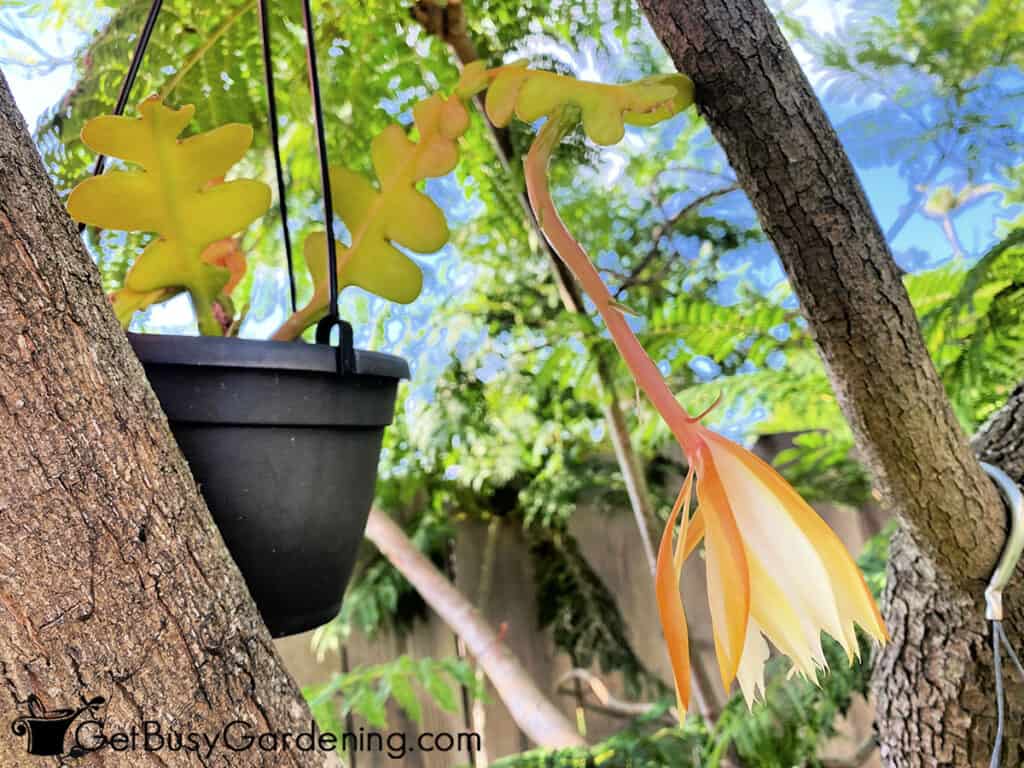
Soil
Epiphytes like this one don’t actually require soil to grow. They can anchor themselves to trees and rocks, or you can mount yours to a board.
So you should use a medium that’s gritty, coarse, and well-draining to fill your pots. Orchid bark, peat moss, a fast-draining mix, or general purpose potting soil amended with perlite are all good options.
Repotting
Since they grow so quickly, you may need to repot your ric rac cactus every 1-3 years as part of its regular care. Roots growing out of the bottom, a bulging pot, or slowed growth are all signs it might be time to size it up.
In the spring or summer, gently remove your ric rac cactus from its old container and move it to a new pot that’s 1-2” larger. Plant it at the same depth it was before, fill it in with soil, and water well.
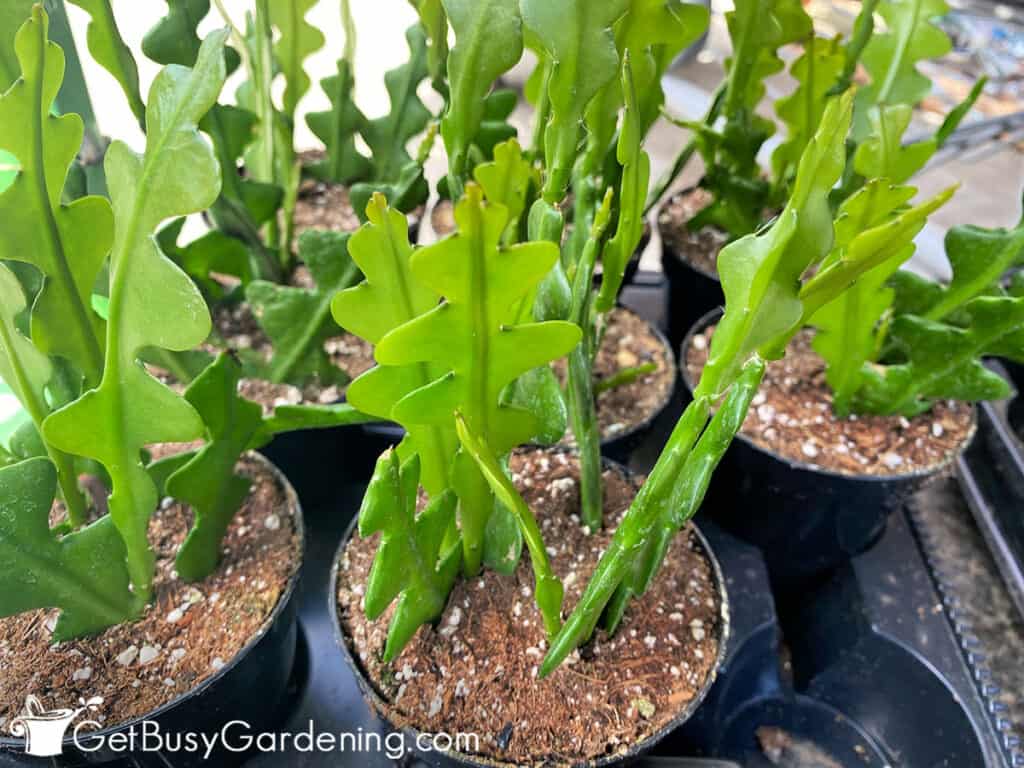
Pruning
Pruning your ric rac cactus is not necessary, but it is good to give it an occasional trim to remove damaged, dead, or leggy branches, and to control its shape and size.
Use sharp, sterile pruning shears to cut away branches wherever they’re too long or damaged. If you don’t like the look of a calloused top, remove the branches at the base instead.
Wear gloves to help protect your hands from the prickly spines between the lobes while you work.
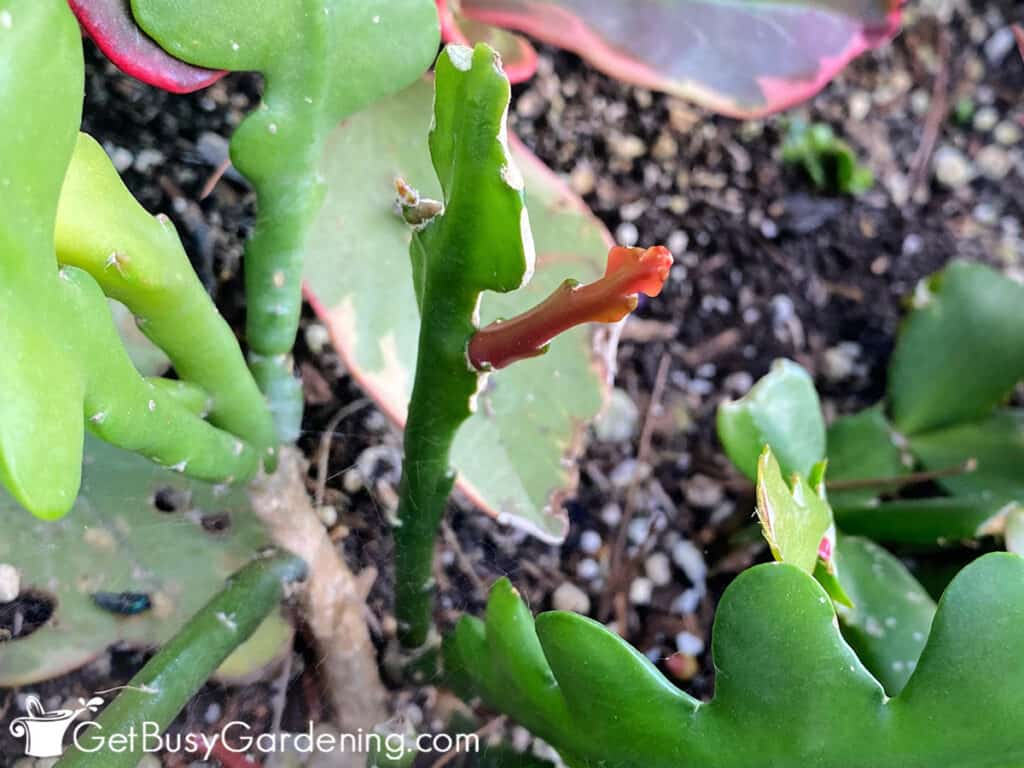
Pest Control Tips
A healthy Epiphyllum anguliger rarely has issues with pests, but mealybugs and scale can occasionally become a problem.
Use a cotton swab dipped in rubbing alcohol to remove any visible bugs, then treat the plant with an insecticidal soap. I make my own by combining 1 teaspoon of mild liquid soap with 1 liter of water.
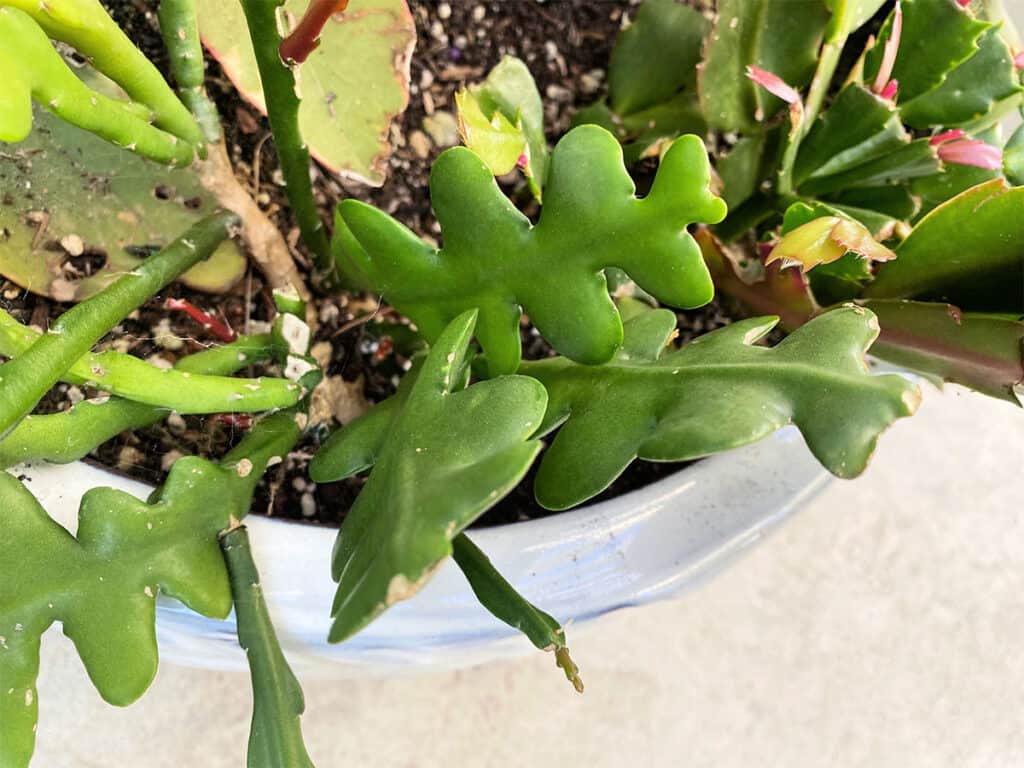
Propagation Tips
You can easily propagate your ric rac cactus in the spring or summer with healthy stem cuttings. Cut a 3-4” section or a whole branch and let it sit out for a day or two to form a callous.
Dip the cut end into rooting hormone, then plant it in lightly moistened, well-draining soil. Put it somewhere warm with indirect light until roots form, then pot it up.
You can also use any aerial roots that form along the branches to propagate your plant. They look like small white tendrils. Gently pin the branch down so the roots are in contact with the soil. Once the branch has rooted, cut it from the mother plant and transfer it to a new pot.
Troubleshooting Common Problems
Even easy-care plants like a ric rac cactus aren’t entirely problem-free. If you happen to run into one of these more common issues, use my tips to help you get your plant back on track.
New Growth Is Skinny
Skinny new growth or leggy branches are caused by lack of light, or from using too much or the wrong kind of fertilizer.
Provide at least 6 hours of bright indirect sun a day, using a grow light indoors if needed to supplement. Avoid feeding your plant more than once a month, and only apply fertilizer in the spring or summer. It’s also best to avoid using flowering plant food outside of early spring.
Stems Rotting
Rotting stems are caused by overwatering or improper soil. It’s important to use a well-draining mix that doesn’t retain too much moisture.
When you water, wait until the top inch has dried out and avoid puddling or making the soil soggy. Ensure you drain away all the excess from the pot as well, so the rootball is never soaking.
Flower Buds Dying
If the flowers shrivel and die quickly after blooming, it’s nothing to worry about. The nocturnal blooms only last for one night.
If, however, the buds are dying before they open, it could be a symptom of stress from underwatering or temperature fluctuation. Keep them between 60-75°F (15.5-24°C) and make sure the soil is never bone dry for long periods.
Yellow Leaves Or Stems
Yellowing leaves or stems are usually caused by improper watering, cold temperatures, or lack of light.
Avoid letting the soil dry out completely, but don’t water so much that it’s wet and sodden. Make sure your plant also receives at least 6 hours of bright light every day and is never exposed to temps below 50°F (10°C).
Brown Leaves Or Stems
Brown stems or leaves on your ric rac cactus are a symptom of improper watering or too much light.
If you overwater, you may notice brown soft stems or spots, which are indicative of rot. Underwatering will lead to dried shriveled stems. Keep the soil moist, but let the top inch dry between drinks, and cut back on watering in the winter.
Direct sunlight can also cause scorched brown spots along the branches. Move your plant to a shadier location or to a window that doesn’t get direct sun in the afternoon.

FAQs
Yes, a ric rac cactus is easy to care for because they’re very durable. Even if you forget to water or don’t give your plant enough sunlight at first, they can often endure and recover just fine.
No, a ric rac cactus doesn’t need to hang. You can grow it in any container with drainage holes, mount it on a board or tree, or train it to climb. However, because it has draping branches, it’s often a popular choice for hanging planters.
No, a ric rac cactus isn’t a rare plant. You can find them for sale in numerous places online or at your favorite local nursery.
Yes, a ric rac cactus can go outside, as long as the temperature is consistently above 50°F (10°C). Also, make sure to put it a spot that provides shade in the afternoon to protect the branches from scorching.
If you want to learn all there is to know about maintaining healthy indoor plants, then you need my Houseplant Care eBook. It will show you everything you need to know about how to keep every plant in your home thriving. Download your copy now!
More Houseplant Care Guides
- How To Care For Pencil Cactus (Euphorbia tirucalli)
- How To Care For Cactus Plants
- How To Care For A Holiday Cactus
Share your ric rac cactus care tips in the comments section below.







Leave a Reply